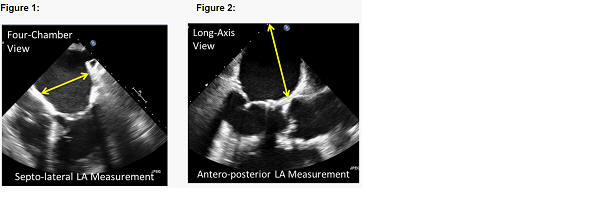 | Prior procedure involving opening of the pericardium or entering the
pericardial space (e.g., CABG, heart transplantation, valve surgery) where
adhesions are suspected |
 | Prior epicardial or endocardial AF ablation procedure; |
 | LA diameter > 6 cm as measured by CT; |
 | Documented embolic stroke, TIA or suspected neurologic event within 3
months prior to the planned intervention; |
 | Currently exhibits NYHA Class IV heart failure symptoms; |
 | Documented history of right heart failure specifically when right
ventricle exceeds the left ventricular size; |
 | Documented history of myocardial infarction (MI) within 3 months prior
to the planned study intervention; |
 | Documented history of unstable angina within 3 months prior to the
planned study intervention; |
 | Recent documented history of cardiogenic shock, hemodynamic
instability or any medical condition in which intra-aortic balloon pump
(IABP) therapy is clinically indicated; |
 | Documented symptomatic carotid disease, defined as > 70% stenosis or >
50% stenosis with symptoms; |
 | Diagnosed active local or systemic infection, septicemia or fever of
unknown origin at time of baseline screening; |
 | Chronic renal insufficiency defined as eGFR < 30 mL/min/1.73m2 within
3 months prior to study treatment; |
 | End Stage Renal Disease (ESRD) or documented history of renal
replacement / dialysis; |
 | Current documented history of clinically significant liver disease
which predisposes the subject to significant bleeding risk (clinically
defined by the treating physician); |
 | Any history of thoracic radiation with the exception of localized
radiation treatment for breast cancer; |
 | Current documented use of long-term treatment with corticoid steroids,
not including use of inhaled steroids for respiratory diseases; |
 | Active pericarditis; |
 | Active endocarditis; |
 | Any documented history or autoimmune disease associated with
pericarditis; |
 | Evidence of pectus excavatum (documented and clinically defined by the
treating physician); |
 | Untreated severe scoliosis (documented and clinically defined by
treating physician); |
 | Thrombocytopenia (platelet count < 100 x 109 /L) based on most recent
pre-procedure assessment within 30 days prior to planned intervention;
|
 | Anemia with hemoglobin concentration of <8 g/dL based on most recent
pre-procedure assessment (within 30 days prior to planned intervention);
|
 | Documented Left Ventricular Ejection Fraction (LVEF) < 30% within 30
days prior to planned intervention; |
 | Known acquired or inherited propensity for forming blood clots (e.g.,
malignancy, Factor V leiden mutation) established by prior objective
testing; |
 | Documented presence of implanted congenital defect closure devices,
(e.g., ASD, PFO or VSD device); |
 | Previously attempted occlusion of the LAA (by any surgical or
percutaneous method); |
 | Inability, unwillingness or contraindication to undergo TEE imaging; |
 | Body Mass Index (BMI) > 40; |
 | Evidence of active Graves disease; |
 | Current untreated hypothyroidism; |
 | Any contraindication to suture, endovascular device, or other
minimally invasive techniques including percutaneous, transseptal, and/or
sub-xiphoid access; |
 | Subject is pregnant or plans / desires to get pregnant within next 12
months; |
 | Current enrollment in an investigation or study of an investigational
device or investigational drug that would interfere with this study and
the required follow up; |
 | Mental impairment or other psychiatric conditions which may not allow
patient to understand the nature, significance and scope of the study;
|
 | Any other criteria, medical illness or comorbidity which would make
the subject unsuitable to participate in this study as determined by the
clinical site Primary Investigator.
|

